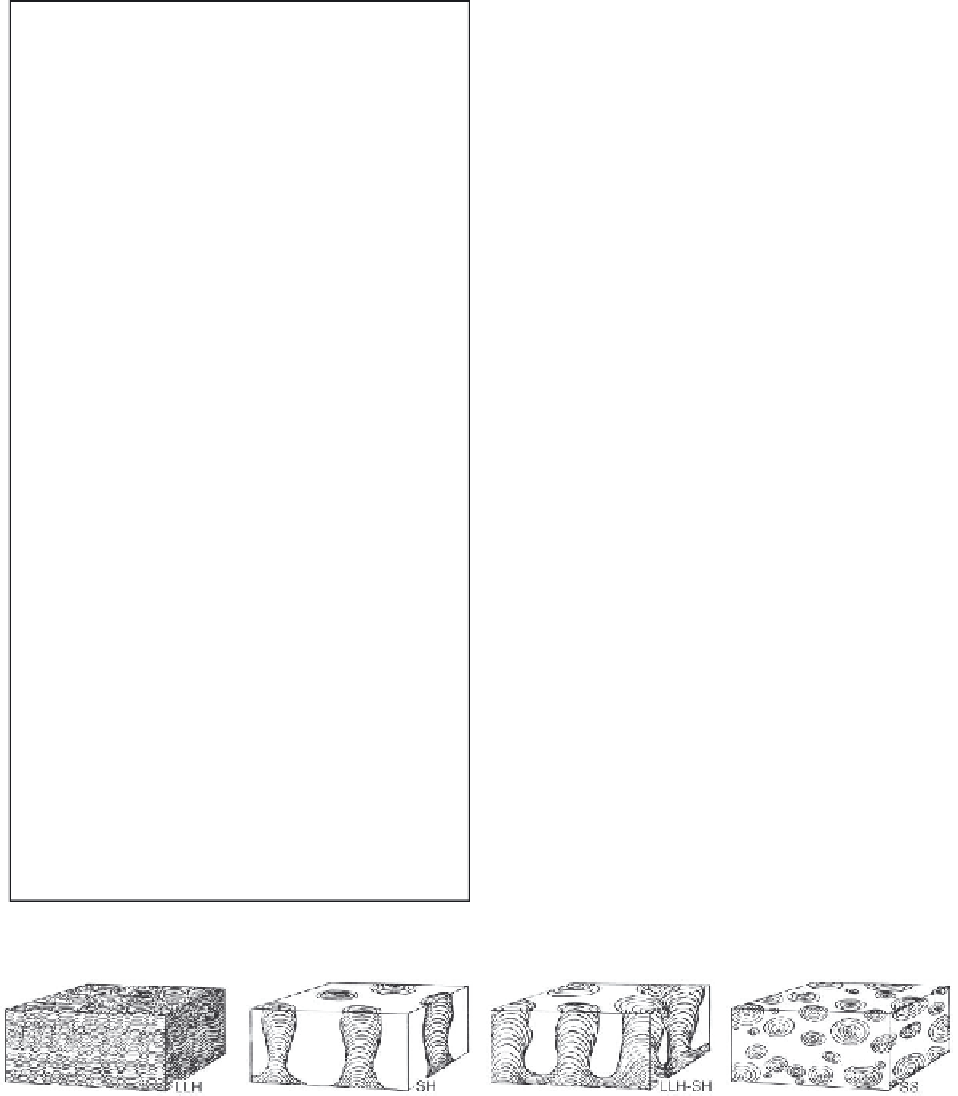Geology Reference
In-Depth Information
forms are common in subtidal settings. This interpreta-
tion may fit the rough shapes of large stromatolite bod-
ies, but the shape of small stromatolites and their con-
structional composition depends strongly on the biota
involved. Lamination, lamina shape, fabric and texture
as well as gross morphology can be substantially con-
trolled by the taxonomic composition of the mat-build-
ing community (Awramik and Semikhatov 1979; Hof-
mann 2000) and reflect the activity of microcom-
munities living under different microenvironmental
conditions (Defarge 1996). Quantitative methods in the
study of stromatolite fabrics facilitate the recogni-
tion of microenvironmental changes.
Box 9.3.
Selected references on modern marginal-ma-
rine and marine microbial mats and stromatolites.
Most references deal with tidal and subtidal settings
which certainly do not represent all the wide varia-
tions of the depositional environments of ancient mi-
crobialites. In modern reefs laminated microbial crusts
occur as coatings on corals and other organisms and
can contribute to the formation of high-energy coral-
algal-stromatolite frameworks.
Bahamas:
Bathurst 1967; Black 1933; Cao and Xue
1985; Dill et al. 1986; Dravis 1983; Feldmann and
MacKenzie 1998; Gebelein 1976; Ginsburg et al.
1977; Hardie 1977; Hardie and Ginsburg 1977;
Macintyre et al. 1996, 2000; Mann and Nelson 1989;
Monty 1965, 1967, 1972, 1976; Neumann et al. 1970;
Park 1977; Paull et al. 1992; Pickney et al. 1995; Reid
and Browne 1991; Reid et al. 1995; Riding 1994;
Riding et al. 1991; Scoffin 1970; Shapiro et al.1995;
Visscher et al. 1998
Florida
: Frost 1974; Gebelein 1976; Ginsburg et al. 1954
Bermuda:
Gebelein 1969, 1976; Sharp 1969
Mediterranean:
Friedman and Krumbein 1985; Fried-
man et al. 1973; Gerdes and Krumbein 1984; Gerdes
et al. 2000
Red Sea:
Friedman 1972
Pacific:
Defarge et al. 1994; Kempe and Kazmierczak
1990, 1993, 1997; Kempe et al. 1996
Shark Bay, western Australia:
Bauld 1981, 1984;
Chivas et al. 1990; Davies 1970; Golubic 1982, 1985,
1992; Hoffman 1976; Logan 1961; Logan and Brown
1986; Logan et al. 1974; Playford 1990; Playford and
Cockbain 1976; Riding 1994; Skyring and Bauld
1990; Walter 1984
South Australia
: Bauld et al. 1980; Skyring et al. 1983
Reef environments:
Cabioch et al. 1999; Camoin and
Montaggioni 1994; Camoin et al. 1999; Macintyre
1993; Macintyre et al. 1996; Marshall 1983;
Montaggioni and Camoin 1993; Reid and Browne
1991; Reitner 1993; Reitner et al. 1995; Scholz 2000;
Sorokin 1973; Steneck et al. 1998; Taylor 1977; Thiel
et al. 1996; Wood 1962
9.1.5 Occurrence and Significance of
Microbialites and Stromatolites
9.1.5.1 Development through Time
Stromatolites and other microbialites played an impor-
tant role in the formation of Precambrian and Phanero-
zoic limestones originating in various settings includ-
ing marine, transitional marginal-marine and nonma-
rine environments. Whereas the microbial contribution
to marginal-marine carbonates was uninterrupted
through time, the role of microbes varied in the forma-
tion of shallow-marine platform and reef carbonates
(Fig. 9.5).
The Golden Age of stromatolites was the period from
2 800 Ma to 1 000 Ma where stromatolites contributed
significantly to the formation of tidal carbonates, plat-
forms and reefs (Fig. 9.4), and during the Proterozoic
reached a maximum in abundance, diversity and lat-
eral environmental expansion (Grotzinger 1989;
Grotz-
Fig. 9.3.
S
tromatolite classification
after Logan et al. (1964). The classification is based on basic geometric forms expressed
by the vertical and lateral arrangement of hemispheroids. Stromatolite growth forms as well as the shape of the lamination is
described by symbols and formulas. These symbols can be used in the field and in the laboratory to describe thin sections and
polished sections.
LLH
:
L
aterally
L
inked
H
emispheroids with laminae whose domes are either
C
losely packed or
S
paced
somewhat apart (subtypes
LLHC
and
LLHS
).
SH
:
S
tacked
H
emispheroids forming columns that are separated by sedi-
ment. The domes of the laminae have either a
C
onstant diameter or
V
arious widths (subtypes
SHC
and
SHV
).
SS
:
S
pheroi-
dal
S
tructures around a nucleus (corresponding to oncoids). Subtypes are
SSC
(characterized by a
C
oncentric structure;
normal oncoid),
SSR
(laminae
R
andomly overlapping), and
SSI
(
I
nverted; laminae facing each other as concentric hemi-
spheres), see Fig. 4/15. Mixed geometric forms can be indicated by a linear combination of symbols, e.g. LLH-SH. The
relations of growth forms and microstructure is expressed by a fraction, whereby the numerator describes the macrostructure
seen in the field and in hand specimens, and the denominator the microstructure seen on a smaller scale as in thin sections.

